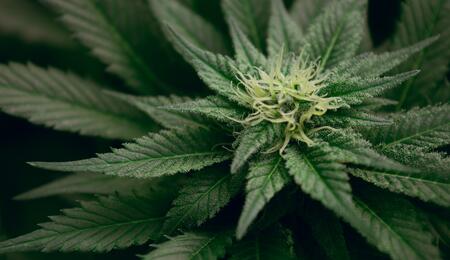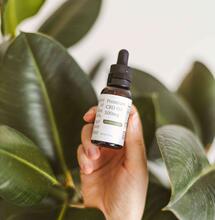When and how to use CO2

Plants need substrates with suitable nutrients and moisture for their roots, but they also need light, warmth, and, indeed, aeration. The aerial part of the plant only needs CO2 during the lighting phase. Through photosynthesis, plants produce sugar compounds from light, water and carbon dioxide. Further nutrients and trace elements also play a decisive role, which however does not come into play in that process. The resulting sugar is the source of energy from which plants derive the strength for their growth, which would be impossible without light, H2O and CO2.
The photosynthesis formula is as follows: 6 H2O and 6 CO2 through the action of light in the green chlorophyll cells give 6 O2 and C6H12O6, i.e. oxygen and dextrose (d-glucose). Water is taken up by the roots, the air exchange is ensured through little pores named stomata on the underside of leaves and light illuminates leaves from above. The conversion of elements – called photosynthesis – takes place in the chloroplasts (organelles of plant cells). It is argued that, if a plant receives abundant water and light, it can grow faster with higher CO2 content.
Now this argument is only true for C3 plants, which first form C3 compounds during the conversion of water and CO2. In C4 plants, a photosynthetic efficiency level is reached at 200 ppm and above of CO2 in the air; this efficiency level may not be increased by higher CO2 concentrations. Currently, as a result of burnt fossil fuels, the air contains about 380 ppm of CO2. In this case, the efficiency of a C3 plant can only reach just 50% of that of C4 plants.
Only from about 800 ppm can a C3 plant convert more CO2 and therefore become more productive. Wheat, rye, rice, oat and hemp are C3 plants. Sugar cane, sorghum and maize are C4 plants. Moreover, a distinction is made between sun-loving and shade-loving plants.
The latter only need very little light to reach 100% efficiency for their growth; more light will not increase growth but rather damage the plants. Sun-loving plants, instead, need more light in order to reach the efficiency level of shade-loving plants. With ten times as much light, however, their efficiency will be five times higher. Above this level, efficiency can no longer increase appreciably through more light. The other types of plants that exist in nature are CAM plants, which excel with aridity. In addition to these three concepts of oxygenic photosynthesis, there are also anoxygenic processes, in which no oxygen is released.
This is just a sketchy description given by theory; in practice, however, one cannot rely on unprofessional estimates, as temperature, water availability, nutritional balance, soil condition and other factors also play a key role. Among other key factors is the potential of a plant species and its adaptation to the prevailing situation. As a result, with the current air content of 380 ppm of CO2, maize has a very high yield potential. Hemp, however, can easily compete, is more ecological and lends itself to a much higher number of fields of application.
This theory explains why an artificially increased CO2 content in the air can imply a considerably high growth of hemp plants, which will ultimately mature faster with a much higher harvest weight. The implication is that growers may double their profits and the time saved should also be factored in for the calculation of such profit increase. Now, as more importance should be attached to work efficiency, especially in indoor growing (for the higher use of space, equipment and energy), CO2 gasification of a facility could significantly contribute to cost efficiency.
In this respect, several products are available on the market to increase the CO2 value in the grow room: i.e. a CO2 controlling unit for drawing gas from cylinders; a CO2 computer for such drawing operation to be accurate; CO2 tabs for releasing CO2 into irrigation water; CO2 bioreactors to obtain CO2 from biomass through fermentation; an acid to extract CO2 from lime; or a gas burner for the extraction of CO2. Of course, the list above does not include all product families and it is also possible to use technical devices to extract CO2 from exhaust or outdoor air and feed it to the room. Growers have already tried some of these products without neglecting CO2 gasification. Many did not spare their time or money, but could not significantly improve their results and, in some cases, their results were even worse.
Of course, dealers stick labels with very promising catchwords and slogans on their products in order to sell them. In the CO2 gasification segment too there are better products or techniques. Even if growers buy the right products, these should be used appropriately in order to be effective. High-power aeration in a grow room can already avoid CO2 gasification of any form without the need to completely alter the facility, and gasification in itself may prove to be ineffective as CO2 could simply flow out of the window.
If, for instance, CO2 tabs are dissolved in irrigation water, the CO2 contained in the water will be absorbed by roots, which should imply a better CO2 supply to plants. Care should be taken to always dissolve a tab shortly before the watering cycle, as CO2 may easily be dispersed from water. This is the theory. Even if a hemp plant can absorb some CO2 quantity by its roots, the effect will not be appreciable. In cannabis – just like in most other terrestrial plants – a gas exchange for photosynthesis takes place on the stomata of leaves. This gas exchange occurs directly where the gas is needed. Similarly, hemp roots absolutely need air in the soil substrate for them to breathe. In other words they need oxygen. Root breathing is important but is of no use for photosynthesis.
Carbon could also be added for it to be transported to the leaves through root absorption. In fish-keeping a C fertiliser is used with the required quantity of carbon not bound to oxygen. But water plants function somewhat differently from terrestrial plants and there is no experience whatsoever with one such carbon fertiliser having been used for marihuana growing.
However, absorption through roots always seems to be the most counterproductive way to supply CO2 to plants, even if a few manufacturers say otherwise. On the basis of the above considerations, the supply of CO2 to hemp plants through room air should be favoured. Therefore growers who often aerate their room can either forget about CO2 supply or completely change and adapt their facility, i.e. instead of having permanent air circulation, air will be recirculated every two hours and during the dark phase of the lighting cycle.
In the latter case, the plant needs no CO2 and releases no O2, consumes some O2 and gives off some CO2. For this reason, a CO2 supply is only appropriate during the bright phase and should be controlled by a timer or a CO2 computer. If air is only recirculated in the grow room every two hours, humidity and, normally, temperature will also increase. At about 380 ppm of CO2, if the air temperature is around 24 to 26° C during the bright phase (in which case plants are in a functionally optimal state), when the CO2 content ideally rises to 1600 ppm, temperature should be around 30 to 34° C.
This rise in temperature is particularly important for plants to favourably exploit the higher CO2 content. Nevertheless, if temperature is considerably higher, the plant growth will stop, as the plant will devote its efforts to endure the heat, which in any case will not damage the plant.
In order to limit evaporation, the stomata, which are indispensable for breathing, will be closed. Growth will stop from around 36° C. For this reason, temperature should always be kept below this value even by CO2 gasification. This consequently means that an air-conditioning system should be installed in the grow room for air to be chilled and dehumidified.
As far as chilling is concerned, growers who cannot simply cool down water temperature by using water supplied from a cold mountain tributary lake or a siphon placed deep down in the soil, will have to use a lot of energy. This also applies to air dehumidification. A dehumidifier should be used in such a way that exhaust heat will be formed outside the grow room. In addition to these technical changes, the used gasification chamber should be hermetically sealed for air not to circulate without ventilation. If the selected space for plant growth is likely to be affected by a build-up of warm air, presumably the cost of cooling will turn out to be too high.
In any case, the use of costly LEDs is justified despite their high cost. The warm air build-up will be considerably lower with LEDs, provided that such lighting devices are well engineered for growing good marihuana. However, to create a hermetically sealed chamber for CO2 gasification there is a need to limit the choice to a room that ensures a cool and dry environment. If you choose a cellar that is already mouldy by moisture or is not adequately aerated, you will also have to consider a very high cost of air dehumidification.
Nonetheless Ed Rosenthal firmly believes that growers may improve their cost balance with CO2, gasification, if it is correctly implemented, as a higher and faster return on the initial investment justifies the cost surplus. For a normal grow room, it is estimated that around 80% of power could be used for lighting. In a hermetically sealed chamber for CO2 gasification, the amount of absorbed power could perhaps be reduced to only 20% even in inaccurately selected rooms.
Cooling and dehumidification are associated with high energy absorption, if the grower has virtually no cold water for extensive water cooling. In addition, a part of air humidity could simply condense and run off in the chamber. For growers to harvest in hermetically sealed CO2 gasification chambers and maximise profits at the same time, all other required steps need to be taken, and they should be able to do so! Those who use the wrong soil or wrong plants will not be happy with the final results.
The growing process should be envisioned as a pyramid, i.e. if the first level is totally inexistent or not perfectly completed, it will still be possible to implement the second level, but noting positive will be achieved. Only if basic work is perfect will further optimisation be of any use. By contrast, if basic work is clumsy, any search for optimisation will create even more damages. Growers whose results are comparatively worse at growing cycle 08/15 should only improve their basic work first and only then think about complex optimisations. For the running costs they have to cover, there is normally very little difference whether or not there is any harvest in a grow room.
The higher the actual cost per square metre is, the more experienced should a grower be. Furthermore, those who use power to light, cool and dehumidify are considerably dependent on the price of electricity, which means that CO2 gasification is another cost that could be added to the power bill. Almost consistently throughout Germany, the cost of energy is much more expensive than in a few other EU countries, whereas in the USA the energy cost varies considerably from State to State, reportedly from below 10 to above 30 US cent per KW/h.
Growers who pay four times as much for their electricity compared to other regions will work uneconomically if they use CO2 gasification. This is why Ed Rosenthal’s opinion could be right for a few US states, but probably not for others. Growers, therefore, should first think very carefully about the cost of equipping their grow room, as well as of all other running costs, and perhaps only start with a test system. As most growers cannot easily pick their rooms but rather work with any spaces available to them, such choice can perhaps make sense for some but not for others. This would at least explain why a few growers, like Ed Rosenthal, rely on those systems, while others cannot report any significant differences in their overall experience.
If as a readers of this article you are into energy saving, you would rightly shake your head and say: “What? everyone talks about measures to save energy and marihuana is now grown as an agricultural product in chilled rooms with artificial light?” You might have simply installed an outdoor conditioning system in summer for your terrace! What is the sun shining for? What have greenhouses been built for? For tomatoes!
Unfortunately marihuana is still illegal and, therefore, such transgressions in production come as no surprise: the prohibition of marihuana is silly, but indoor growers, who have merely adapted themselves to the market and have to meet their own or other people’s demand, are surely not. If a product is in demand, it is also produced and traded, this is something that prohibitions cannot change. Therefore, especially in the case of drugs, given the undiminished demand, a below-average product attributable to prohibitions is not safer but rather even more dangerous!



